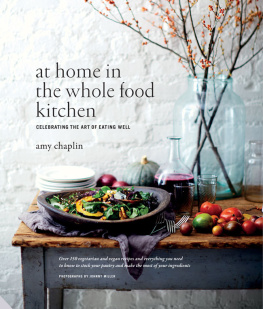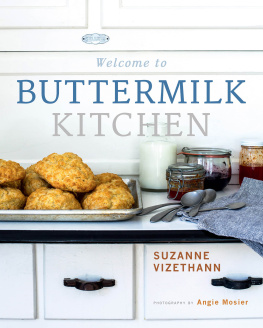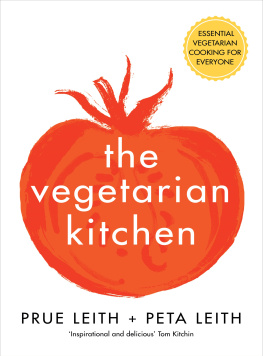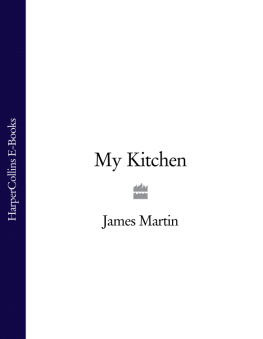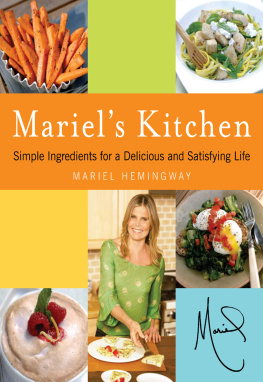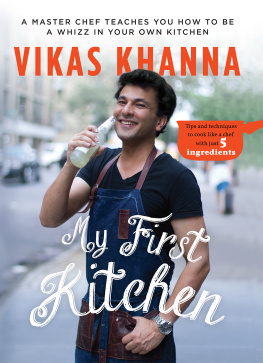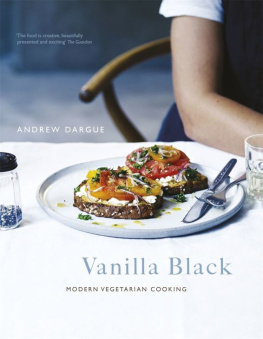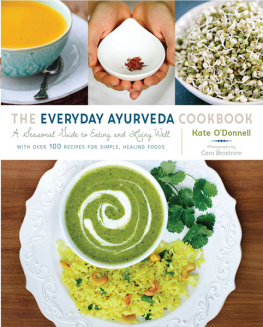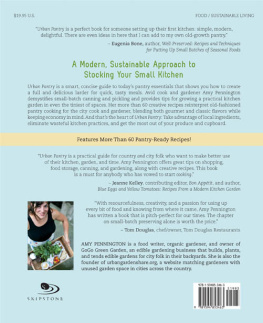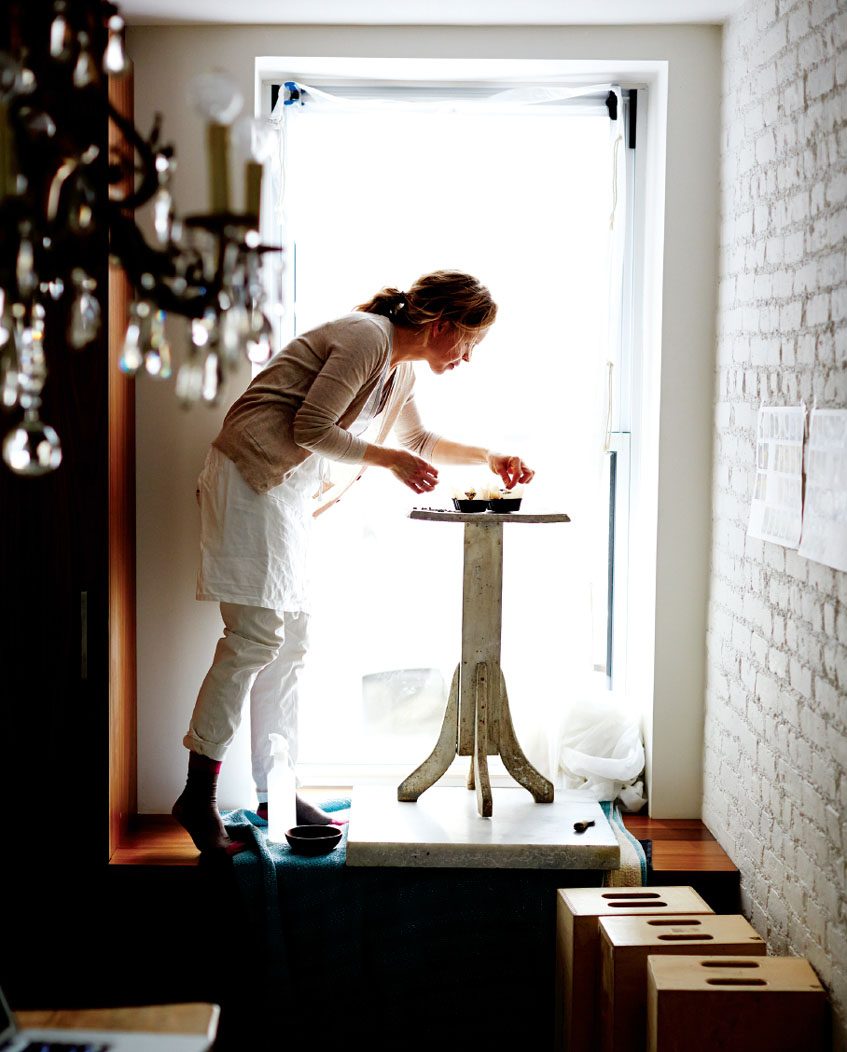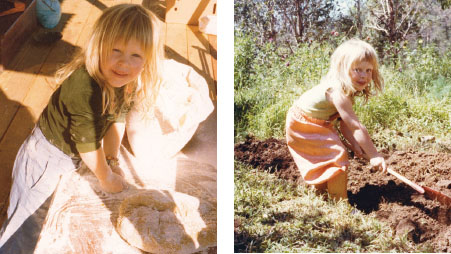for
Jacqui,
with all my love, x
CONTENTS
introduction
My relationship with food and nature goes further back than I can remember. I suppose I really did inherit my love of good food from my mother and father. I was raised in a remote area of rural New South Wales, Australia, by vegetarian parents who grew and cooked everything we ate. My parents migrated up the coast to a developing community farm before I could walk, because they wanted to live off the land as much as possible.
Our family home an octagon-shaped, mud-brick house was built around the kitchen. We all spent a great deal of time in that large open room washing, chopping and cooking vegetables; sharing meals; and in winter, warming ourselves by the wood-burning stove.
My father designed and built the house with hand-made, sun-dried mud bricks; reclaimed wood and windows; and antique doors. When I was an infant, my mother bathed me in the kitchen sink; once I could sit up on my own, she perched me on the worktop to keep an eye on me as she cooked our daily meals. I sampled whatever she happened to be making, and as soon as I could hold a spoon, the job of stirring (and tasting) cake mix was mine. Before long, I graduated to using a small knife and chopped the chives and parsley picked from the garden that we added to almost all our meals.
As a child, a weekly high point for me was helping my father make our bread. He would set me up at a low table so I was able to knead the dough. I loved creating my own mini rolls from the excess dough, which I filled with dried fruit and spices.
My sister and I were involved in everything my parents did: keeping bees, brewing ginger beer, moulding the mud bricks to build the house, making tofu, creating biodynamic preparations for the property and grinding wheat into flour. We were also part of the process of planting, harvesting and cooking the food we ate; inevitably composting our food scraps, which were eventually used to fertilize the garden.
There were no shops within a 50-kilometre (30-mile) radius of where we lived, so being well prepared on the food front was ingrained from an early age. Besides growing fruits, vegetables and herbs on our land, my parents ordered bulk grains, nuts, seeds, dried fruits and olive oil, which sat in jars on an old dresser in the kitchen. The image of those large jars filled with wholesome ingredients has been central to inspiring me to create new recipes over these many years as a chef.
In addition to having a well-stocked pantry at home, we packed meals whenever we went on road trips; my mother still travels with a picnic blanket and a billy can (Australian campfire kettle) in her trunk. Sipping tea and eating delicious homemade food out in nature on remote beaches or in subtropical rain forests is something we frequently did. Today, I do this as often as possible and think of it as one of lifes greatest luxuries.
It never occurred to me when I was growing up that as we ate from the garden, collected milk in jars from a local biodynamic farmer and composted and collected rainwater that we were living an ecofriendly lifestyle. This cycle of growing, harvesting, cooking, eating, composting and fertilizing was deeply rooted in us. Even now, though I live in downtown Manhattan, New York City, I continue to compost every food scrap that is created in my kitchen by making biweekly trips to the Lower East Side Ecology Centres compost bins at the Union Square farmers market. I then fill my bags with fresh vegetables and the ever-rewarding cycle begins again.
I attribute my reverence for nature and obsession for seeking out the best-tasting whole foods to spending countless hours in our garden as a child. There I sampled everything we grew and often made herb-vegetable combinations in my mouth as I walked the paths that divided the tiered garden beds.
Those vegetables I casually sampled on a daily basis made a huge impact on my taste buds. I am always seeking ingredients that match the integrity of the produce I grew up with and honouring it with recipes that bring out its best qualities. This is what I strive for as a chef.
The first time I set foot in a working kitchen was at my favourite caf in inner-city Sydney. I got a job there through word of mouth (and lots of enthusiasm!) working the espresso machine and waiting tables. I often found myself helping out in the busy kitchen during the lunch rush and would step in when they were short-handed, making the daily specials. I worked hard and learned a lot in that bustling little caf.
During this period, I was living with friends who followed a macrobiotic diet. Through them and the local macrobiotic restaurant (which quickly became my favourite), I was introduced to the idea of food as medicine. In the short time I lived in Sydney, I cooked a lot and shared many meals with both new and old friends: we ground millet for porridge, roasted copious amounts of vegetables, discovered the endless possibilities of tahini sauce and experimented with vegan desserts just because my awareness for healthy ingredients was expanding, I still didnt consider missing out on dessert! I found I actually preferred the flavour of desserts made with natural sweeteners, nuts and fruit. The challenge of creating a delicious dessert in its own right, without using animal products or refined ingredients, captivated my interest.
I was itching to travel, and less than a year later I arrived in Amsterdam and continued my food journey, this time in a Japanese macrobiotic restaurant, once again waiting tables. Eating the daily staff meal was an education in home-style Japanese food and kept me curious. On my days off, I replicated what I ate for friends and continued my exploration of vegan whole food desserts. To my delight, the owner of the restaurant noticed my interest and zeal for cooking and offered me a position as pastry chef. I was given a few training sessions on traditional Japanese desserts, which solidified my understanding for the way agar and kuzu work and gave me the keys to create any vegan dessert I could imagine. Once my foot was in the kitchen door, I got the chance to learn from some very talented macrobiotic chefs, and in addition to the desserts, I started preparing the daily bento box specials.
Though I still didnt consciously realize that I was moving deeper and deeper into a career in food, it did excite me that I had built a small following and my desserts started selling out nightly. Planning menus and envisioning new flavour combinations occupied my mind and started keeping me up at night. I was inspired by the endless possibilities that food held and bounded out of bed at five am, when the quiet kitchen gave me the space to create. I felt so happy and fortunate to be able to dream up desserts and then create them at work.
Through these early years in my career, I knew I wanted to eat food that tasted great and nourished my body (with indulgences, of course!) while having a minimal environmental impact. I also remained strongly drawn to honouring a connection to nature and the way food has the ability to act as a catalyst for this. As my knowledge about the benefits of vegan and macrobiotic diets deepened, the world of plant-based whole foods commanded my full attention; its seemingly endless possibilities still inspire me as much today as they did when I was first starting out as a chef. Though the structure of cooking this way grabbed my attention, I also wanted to find ways to infuse my food with the element of celebration with which I was raised, the festive quality that I think defines many Australians approach to food.

